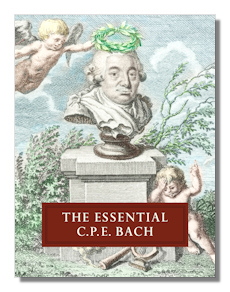
The Internet's Premier Classical Music Source
Related Links
-
Introduction
Acoustics
Ballet
Biographies
Chamber Music
Composers & Composition
Conducting
Criticism & Commentary
Discographies & CD Guides
Fiction
History
Humor
Illustrations & Photos
Instrumental
Lieder
Music Appreciation
Music Education
Music Industry
Music and the Mind
Opera
Orchestration
Reference Works
Scores
Thematic Indices
Theory & Analysis
Vocal Technique
Search Amazon
Recommended Links
Site News
 Book Review
Book Review
The Essential C.P.E. Bach

Selected with an Introduction by Paul Corneilson
Carl Philipp Emanuel Bach
Packard Humanities Institute, xxxvi + 356 pp
ISBN-13: 9781938325342
This year, 2014, is the tercentenary of the birth of J.S. Bach's second son, Carl Philipp Emanuel, who lived until 1788. It's often asserted that Wilhelm Friedemann (1710-1784), the eldest, was the more inventive. Further, Emanuel's music equally sometimes goes unheard, or dismissed as "mere" stil galant note-spinning. If this anniversary does anything, it's to be hoped that it opens ears (and hearts) to how profound, original and enjoyable Emanuel's music is.
CPE Bach wrote in almost all musical genres of his time, except opera. He was also one of the most influential composers of the eighteenth century, Mozart famously saying that C.P.E. Bach was the father (to the younger composer's generation). Anything more than cursory attention to CPE's works could well be a revelation if they're unknown to you. They have beauty, breadth and variety. Even, in places, the combination of light and profundity with which we more often associate Emanuel's father. For serious listeners, as always, a score can shine additional, welcome, light. A good score can vastly increase the pleasure.
In 1999 a significant discovery of CPE Bach's works was made in the archives of the Sing-Akademie zu Berlin… the cantatas and Hamburg Passions in particular allowed specialists to contemplate a complete critical C.P.E. Bach Edition. These were previously thought lost and/or destroyed in the Second World War. Now an ambitious project known as the "Carl Philipp Emanuel Bach: The Complete Works (CPEB:CW)" is nearing completion. Headed by the Packard Humanities Institute (Cambridge, Massachusetts), in cooperation with the Bach-Archiv Leipzig, the Sächsische Akademie der Wissenschaften zu Leipzig, and Harvard University, the edition is available in both printed and digital formats and divided into eight sections:
- keyboard music,
- chamber music,
- orchestral music,
- oratorios, passions,
- choral,
- songs, vocal chamber music,
- theoretical writings,
- supplement and facsimile supplements.
The editors point out that the "CPEB:CW" is a "living edition": there is a procedure for drawing potential errors to their attention for correction online; new relevant material can and will be similarly added and amended. All (known) works by C.P.E. Bach which can be or have been authenticated are included; the same goes for judiciously-considered uncertain ones, though not those known to have been misattributed or wrongly ascribed altogether. Although it's usually the latest (authenticated) work that's included, alternative and variant works and movements are also part of the Edition.
The "CPEB:CW" would not be so useful and valuable were it not for the monumental effort in planning and execution that has obviously gone into it. The constitution of the editorial boards all but assures that the highest level of scholarship will propel the project into the very front line of work of its kind… chaired by Christopher Hogwood, others advising and contributing include Christoph Wolff, Peter Wollny, Darrell Berg, with Paul Corneilson as managing editor. Likely to stand for the foreseeable future as the definitive publication of its kind, it's also highly approachable for the individual music lover, performer and listener. Individual volumes can be purchased online and individual performing material is available for download free of charge from the project's website, which also contains a simple and informative set of (online) resources about the composer.
The specific single-volume anthology under consideration here has been released as both a taster of what's available in the entire series; and as a useful standalone set of nearly 30 examples of CPE Bach… from his solo keyboard to chamber music; with two Symphonies (Wq 177, Wq 183/1) and two Concerti (Wq 25, Wq 43/4) as typical of his orchestral music; and ending with eight examples – including the chorus from the "Magnificat", Wq 215 – of the composer's vocal music.
There is no up-to-date study of C.P.E. Bach – for the moment: a review of a new biography of C.P.E. Bach will be published on Classical Net this Fall. So this is also a volume that provides a compact introduction to his world and compositions through an illuminating gloss on the works contained here by series editor Paul Corneilson. What's more, there are selected bibliography and discography as well as several figures, facsimiles of contemporary autograph manuscripts and title pages etc (it's to be noted that this edition – in common with those others in the series – does use modern typesetting/notation, not reproductions) as well as a short concordance with Wotquenne and Helm numbers for the works here published; and a useful table of abbreviations, both general and in reference to sources etc.
The volume examined and evaluated for this review is physically large: almost 13" x 10". Production standards are excellent: the color of the paper used (a creamy off white) shows up everything in the crisply set staves perfectly. The pages are large and clear enough for the volume to be used as a performing edition (it has a robust sewn binding), as well as study score. Those works with texts have them printed in a serif font but highly legible. So strikingly easy to read and uncluttered is the typesetting of the series that it has already won a couple of awards for design. What's more, it's very reasonably priced – as are the other volumes in this excellent series. This is the kind of enterprise that does credit to everyone involved. It meets multiple, clearly defined needs very well indeed and can be recommended in every respect.
Copyright © 2014 by Mark Sealey.












